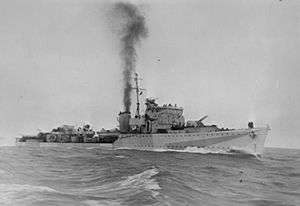HMS Quorn (L66)
HMS Quorn was a Hunt-class destroyer of the Royal Navy, built in 1940 and sunk off the Normandy coast on 3 August 1944.
 HMS Quorn underway in 1940 (IWM) | |
| History | |
|---|---|
| Name: | HMS Quorn |
| Builder: | J. Samuel White and Co. at Cowes, Isle of Wight |
| Launched: | 27 March 1940 |
| Commissioned: | 21 September 1940 |
| Identification: | pennant number: L66 |
| Fate: | sunk 3 August 1944 off the Normandy coast |
| General characteristics | |
| Class and type: | Hunt-class destroyer |
| Displacement: |
|
| Length: | 85 m (278 ft 10 in) o/a |
| Beam: | 8.8 m (28 ft 10 in) |
| Draught: | 3.27 m (10 ft 9 in) |
| Propulsion: |
|
| Speed: |
|
| Range: |
|
| Complement: | 146 |
| Armament: |
|
History
Quorn was built by J. Samuel White and Co. at Cowes, Isle of Wight. A Type 1 Hunt-class destroyer, she was launched on 27 March 1940 and completed on 21 September 1940 with the pennant number L66.[1] She was adopted by the civil community of Rushden, Northamptonshire, as part of Warship Week in 1942.
Quorn then joined the 21st Destroyer Flotilla at Harwich. The flotilla was tasked with convoy protection, anti-shipping and patrol duties. Quorn would stay with this flotilla for the whole of her commission.
In April 1941 Quorn was superficially damaged by two delay-action bombs, that exploded 20 metres (66 ft) from her port quarter.
In August 1941 whilst on passage from Harwich to Chatham, Quorn set off a mine 40 metres (130 ft) off her port bow. She was repaired at Chatham Dockyard. This took until September 1941 to complete.
In April 1942 Quorn hit a mine that blew a 9 by 15 feet (2.7 m × 4.6 m) hole in the port side of the ship. She was towed to Harwich and then to Sheerness where repairs took 4 months to complete.
On 13 October 1942 Quorn was one of the five destroyers that intercepted the German auxiliary cruiser Komet in the English Channel. Komet was sunk and two M-class minesweepers were heavily damaged and set on fire. An hour later a second patrolling force of the same operation engaged a group of escort vessels, sinking an R boat and damaging a T boat.
In June 1944 Quorn was an escort for convoys of personnel during Operation Neptune, the naval support of Operation Overlord, the Normandy Landings. On 3 August, she was hit and sunk by a human torpedo piloted by Oberfernschreibmeister Herbert Berrer of the Kriegsmarine during a heavy attack on the British assault area by a force of E-boats, Linse explosive motorboats, human torpedoes and low flying aircraft.[2] Those that survived the initial attack spent up to eight hours in the water before being rescued, and many of these perished. Four officers and 126 ratings were lost.
References
- Mason, Geoffrey B. (2004). Gordon Smith (ed.). "HMS Quorn (L 66) - Type I, Hunt-class Escort Destroyer". naval-history.net. Retrieved 4 May 2015.
- Brown, p. 116
Publications
- Brown, David. Warship Losses of World War Two. Arms and Armour, London, Great Britain, 1990. ISBN 0-85368-802-8.
- Colledge, J. J.; Warlow, Ben (2006) [1969]. Ships of the Royal Navy: The Complete Record of all Fighting Ships of the Royal Navy (Rev. ed.). London: Chatham Publishing. ISBN 978-1-86176-281-8.
- The Hunts: a history of the design, development and careers of the 86 destroyers of this class built for the Royal and Allied Navies during World War II, John English, World Ship Society, 1987, ISBN 0-905617-44-4